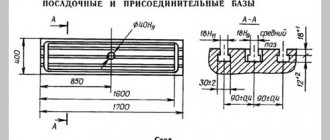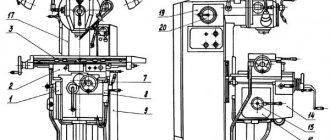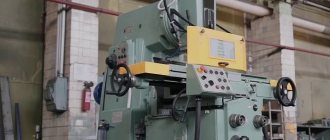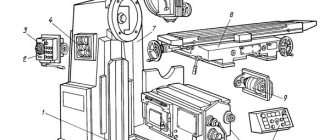Among the various machine tools, milling machines make up a significant share of the volume of metal-cutting equipment, including those with numerical control. The main advantage of the machine is detected when processing shaped parts. Here he is irreplaceable, and no other can compete with him. The milling machine works more quietly, without impacts and jolts, as happens on planing and slotting machines, as a result of which all mechanisms last longer.
But whatever the advantages, they will be lost if you do not learn how to properly handle the equipment and use all its capabilities.
Depending on the functions performed, milling machines have the following types:
- vertical;
- horizontal;
- drilling;
- tabletop and tabletop CNC;
- universal;
- universal;
- CNC machines and CNC machining centers.
Characteristics of vertical milling machines
A vertical milling machine is called so because the spindle, on which the workpiece fastening devices or the workpiece itself is mounted, is located vertically to the working area of the table. It was one of the first equipment to be used in the processing of metal products. They are used for processing heavy and large parts and have increased rigidity, which ensures precision processing.
The machine has end, face, cylindrical and shaped cutters , so it can perform various milling operations . Drilling work can be carried out on it. You can bore and countersink holes, cut grooves, teeth, frames, gears, and corners.
The equipment works with various types of metals and alloys, as well as plastics.
There are two types of vertical milling machine:
- Machine without console.
- Machine with console.
A machine without a console has a table located on a fixed frame and is called a cross machine. It moves in the transverse and longitudinal direction. The machine is controlled from a pendant console, and the spindle speed is set using hydraulics. Precise movement of the table is carried out by slowing down the speed. The semi-automatic cycle on which the mechanisms can operate ensures fast movement and stopping in the required position.
The difference between machines with a console and models without a console is the presence of a moving console on which the table and slide are placed. The table moves horizontally along the console guides. The console itself moves in three perpendicular directions. A feed box is mounted on it.
on the feed of the working table .
Milling machine 6K11
This unit is designed to perform basic work such as milling, drilling, boring holes and others. The equipment is focused on working with metals and plastics.
This truly versatile vertical milling machine can be used both in small-scale production environments and as key equipment in large-scale industrial facilities. The design provides a special tool clamping mechanism, which significantly expands the capabilities of the equipment.
A little about the parameters of 6K11. The dimensions of his workplace are 250x1000 millimeters. The table travel is 710, 250 and 400 millimeters (longitudinal, transverse and vertical, respectively). The power of the vertical spindle motor is 5.5 kW, and the feed motor is 1.5 kW. The dimensions of the unit are quite modest - only 2135x1725x2290 millimeters. And the weight of the model reaches 2350 kg.
Technical capabilities
Since the machine is characterized by a vertical arrangement of components, you need to know and take into account the height of the model and its dimensions. You can evaluate the technical capabilities of the design by answering the following questions:
- What power does the power plant have?
- Is there a cooling system?
- What type of control: manual or electronic?
- How many speed switching speeds?
- How can you characterize the course of the table?
- What is the number of revolutions of the spindle head?
- What are the restrictions on the workpiece in terms of weight and dimensions?
All these questions can be answered by studying the technical data sheet of the model. This will allow you to make the right choice.
Cantilever and non-cantilever designs
By design, there are two main VFS models:
- Cantilever structures. Such machine models contain an additional part called a console. It is located under the processing table, and it is attached to a cylindrical post and bed. Often the console is a movable element, so during operation of the machine it is not the table itself that can be moved, but the console installation. The use of a console clamp simplifies the work and also allows you to more securely fix the workpiece on the table.
- Non-cantilever designs. Such models do not contain a console stand, and the table is attached directly to the pillar and frame. The absence of a console increases the rigidity of the VFS, and also makes it possible to process large-sized spare parts that would not fit on the machine if there was a console. In practice, non-cantilever structures are less common than cantilever ones, but they are small in size, so they are used more often in small-scale metallurgy.
According to the design of the VFS, a distinction is also made between standard models and CNC units. The CNC vertical milling machine is additionally equipped with an electric drive system and an electronic panel, which allows you to control the VFS in automatic or manual mode. For example, using CNC, a worker can set the speed of automatic movement of a table with a part, while using buttons or switches he can manually select the rotation speed of the cutter.
To control CNC models, various devices can be used - knobs, buttons. CNC models are more convenient, and a worker will not need much time to master them. However, a CNC vertical milling machine is more complex to manufacture, since it contains many additional parts, assemblies, and autonomous elements. Therefore, CNC models are several times more expensive than manual installations.
Modern models
Modern industrial enterprises widely use high-precision numerical control equipment, however, it is impossible to imagine an enterprise without mechanically controlled equipment. Although it can be called mechanical only conditionally, since almost all structural elements are powered by electric drives. The table and spindle feed drives remained mechanical, with duplication of setting a constant numerical feed value by an electric drive.
Manufacturers of vertical milling machines produce models that have equally recognizable features.
The main disadvantage of all models can be considered high cost and limited service life. In addition, it is difficult to find a specialist who can repair the problem if the supplier does not provide follow-up service after selling the product.
Vertical milling machines include the following models: 6М12П, 6Р12Б, 6С12, 6Н12, 6Р12, 6Т12. They have found wide application not only in the former republics of the USSR, but are also successfully exported abroad. This is reliable, high-quality equipment that does not require close attention. Modern factories systematically improve the design of equipment and, if possible, increase the cutting speed. From year to year, the technological capabilities of various models are improving.
Technical specifications
In order to clearly understand what requirements a particular machine meets, it is important to have an idea of its main parameters. Today, the range of such equipment is truly huge. Companies produce equipment in a variety of sizes and with different power ratings. The market offers both desktop units aimed at domestic use and professional milling machines capable of operating in harsh production conditions.
When choosing the ideal unit for yourself, a master should focus on such key characteristics as:
- Power is perhaps the main parameter that gives an idea not only of the performance of the equipment, but also of the scope of its use.
- Characteristics of the workspace. This includes the dimensions of the desktop, distance from the spindle, spindle stroke and other parameters.
- The spindle speed is a characteristic that clearly demonstrates the processing speed of the part and determines the equipment option.
Today, there are 3 main types of universal vertical milling machines, depending on the type of control. Manual machines are the most “ancient”, but irreplaceable units in small workshops. Automatically controlled or numerically controlled equipment are more complex structures that require the appropriate level of qualifications to operate them effectively. This is especially true for CNC machines.
Let's look at some of the popular models to understand what types of equipment are potentially available to the master today.
Machine manufacturers
One of the well-known manufacturers of lathes is the joint stock company TRENS (Slovakia). The peculiarity of this company is the production of high-quality processing and high-precision equipment. At the customer's request, the manufacturer can make changes to the design of the machine. The equipment is available for maintenance and operation.
The leader of European manufacturers of metal-cutting machines , including vertical milling machines, is the TAJMAC - ZPS plant (Czech Republic). The plant has its own foundry, which gives the company independence from external factors. The quality of processing and high technological characteristics of the manufactured equipment allow the products produced by the plant to be used not only in mechanical engineering, but also in rocketry, energy, and aviation enterprises.
The Lipetsk machine tool enterprise produces Russian-made milling machines. The advantage of this relatively young enterprise is that they independently manufacture equipment components, and this significantly reduces the cost without reducing quality.
Milling machine VM127M
This unit is designed to work with metal workpieces in both small-scale and mass production. Among the features of this model are a powerful motor and ideally selected gear ratios. This allows you to select the ideal processing format for a specific part with maximum use of the tool’s capabilities.
The universal vertical milling machine VM127M is capable of operating in automatic mode, which makes it possible to combine several machines into a multi-machine system under the control of one master. The ease of maintenance and adjustment of the operation of units to the needs of a specialist will also be a significant “pro” in favor of the VM127M.
The dimensions of the machine's work table are 400x1600 millimeters. The drive power reaches 11 kW, which is more than enough for efficient processing of parts with high productivity rates. The weight of the machine is just under 5 tons, and its dimensions are 2560x2260x2500 millimeters.
conclusions
Vertical milling machines can become universal assistants in any workshop. Functionality, reliability and endurance are their main advantages. And the variety of models presented these days makes it much easier to choose the equipment that suits all parameters. Today we can say for sure that an experienced master will easily find the unit he needs.
Machine care
Only someone who knows well the structure of all mechanisms and how they operate can properly service the equipment. Basic mechanisms to learn:
- drive unit;
- spindle and its bearings;
- speed and feed box;
- table;
- dividing head;
- accessories and devices.
One of the main conditions that guarantees proper maintenance of equipment is proper timely lubrication and cleanliness of the workplace.
All mechanisms must be adjusted for smooth operation, which means that they must work without stopping or play. Overloading should not be allowed, as this will affect the operation of the machine. The result of the work is influenced by the fastening of the cutter and the workpiece. Rotating the cutter in the opposite direction is unacceptable. Its teeth will crumble and it will become unusable.
Do not place foreign objects on the machine table. The chips that form on the table must be removed frequently, as they not only interfere with observing the work of the cutter, but also fill the gaps between the teeth, increasing friction and energy consumption.
It is necessary to ensure that the waste liquid is drained into the reservoir, since if the liquid spills chaotically, it can mix with the oil and reduce the quality of the lubricant. After use, the equipment must be wiped with a dry cloth.
Do not leave machinery unattended during operation.
Design
All VFS consist of the following elements:
- Foundation slab. Acts as a base on which all other parts (frame, console) are attached. The plate has a high weight, which allows you to securely fix the installation on the site. The plate is wider than the frame with the console installed, however, compact models of machines may have a plate of reduced dimensions.
- Block fixed bed. The part is attached to the top of the stove and acts as a base on which the console and trunk are installed. An electric motor is also attached to the frame, which powers other installation components (milling cutter, console table, CNC).
- Fixing trunk. The spare part is installed on top of the frame. The trunk is long, and at its end the main elements of the milling unit (cutter and spindle) are installed to process the part. Ancillary parts can be installed on the trunk - power regulator, CNC panel.
- Spindle and cutter. The spindle is a vertical shaft to which a cutter is attached using clamps or threads. It is a tool to which one or more machining teeth are attached. During operation, the cutter rotates at high speed and processes metal (cutting, drilling, removing layers). The spindle and cutter are attached to the fixing trunk.
- Processing table. The table is an elongated movable surface on which the surfaces to be processed are placed. It is mounted on a cylindrical pole, which allows its height to be changed (mechanically or electrically). Many vertical milling machines also contain a bracket-console on which the processing table is attached (we will look at this issue in more detail below).
What other milling machines are there?
There are also other types of machines - horizontal, drilling, tabletop. They perform the same functions as vertical milling structures, and they are also used mainly for processing products or structures. However, they may have differences - additional components or assemblies, the direction of processing, the presence of auxiliary processing units.
Horizontal milling
In such machines, the spindle is located not in a vertical, but in a horizontal plane, which determines a different way of processing parts. Horizontal installations are great for working with small objects based on metal, wood or plastic. The horizontal location of the fastening allows the use of additional cutting cutters (cylindrical, shaped, end, corner). Horizontal machines can be equipped with auxiliary equipment that allows processing of screw and inclined surfaces, which makes them almost universal.
Drilling and milling
Drilling and milling machines are used for drilling metal, wood, plastic, and ceramic products. An important feature is the unusual arrangement of the tool being processed, so with the help of such a machine you can drill inclined holes and process grooves of large-sized products. The drill head can rotate in both forward and reverse directions, which greatly simplifies the work with such a machine. Drilling and milling machines are now in great demand in both large and small manufacturing industries, as well as in the field of home metal processing.
Universal
They can process parts of any size and shape, and if necessary, the part can be tilted at any angle to the working tool during processing. Another design difference is that the spindle, table, and cylinder table are located inside the hollow frame, and all electrical units are placed outside. Universal milling machines are usually used in small and medium-sized workshops. They are also widely used in large metallurgical and manufacturing plants.
Tabletop
Benchtop units are lightweight versions of vertical, horizontal, universal or drill presses. Their main difference is their more compact size - and in all other respects they repeat the original models (dimensions, structure, location of the main components). Tabletop machines are often purchased for the needs of schools, colleges, technical schools and other technical educational institutions. The advantages of desktop systems are low power consumption, good technical properties, and compactness.
Widely versatile
The main design feature of wide-universal milling machines is the presence of an additional spindle with the installed cutting tool. Spindles can work both together and autonomously. Heads with a spindle are usually placed on movable trunks that can be moved in all main directions. For control, CNC panels are usually used to automate the processing procedure. Widely versatile models can work with almost all materials that have high hardness.
Cleaning can be done using various cutters - angular, shaped, cylindrical, inclined. Widely versatile models are used for drilling, countersinking, boring or cleaning surfaces. Universal models are usually used in the field of large metallurgy. It is explained this way:
- High cost of installations. Widely versatile models have a complex design and are equipped with CNC panels that allow you to control the device automatically. This simplifies the work, but has a negative impact on the price (such models are 5-10 times more expensive than regular ones).
- Additional training is needed. If a worker has worked all his life on a vertical, horizontal or universal machine, he will first have to undergo additional training. He will also have to “train his hand” additionally, since working with two cutters is not so easy at first.
- In the field of small processing there is no need for such models. For small workshops, a conventional machine is much more profitable - low price, low power consumption, ease of use. Buying an expensive multi-purpose machine will cost a pretty penny, but the expenses will not pay off soon.








